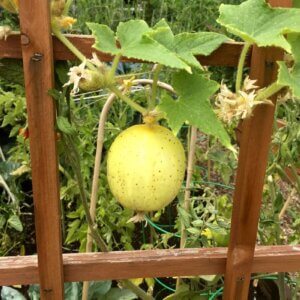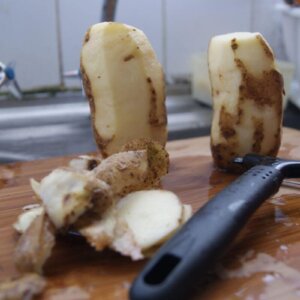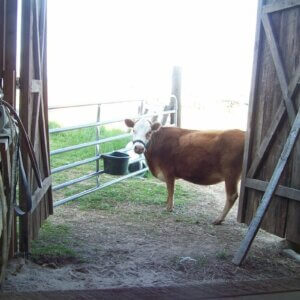
Last summer, I got hooked on the idea of baking pizza and bread outdoors in a wood-fired oven. Baking outside, in a super hot oven with a brick hearth, (the way bread is really meant to be baked) was a hugely appealing thought.
It became very clear to me that I wanted to build a cob oven, which would be fairly easy and quick to build, and very cheap, too. You can build your own cob oven for as little as what you might spend on a pizza delivery on a Friday night!
Cob is an ancient earthen building technique and is the simple combination of sand, clay, and straw. Mixed together, these ingredients create a super durable, long-lasting, heat-tolerant material for building outdoor ovens. (Homes have been built out of cob for thousands of years all over the globe!)
The Outdoor Pizza Oven: Cheap and Green
Compared to masonry ovens, which can cost hundreds or thousands of dollars and usually require cement in their construction (which has a huge embodied energy), a cob oven can be made from very simple, recycled, and locally available materials. They require little more than some sand, clay, straw, sawdust, some bricks, and a pile of rocks and few other recycled materials.

So I picked up a copy of Kiko Denzer’s Build Your Own Earth Oven, a little gem of a book covering the construction of cob ovens from the ground up. And in July, after I settled into my new house, I knew it was time to start building this oven I had been dreaming about, so I could finally make pizza the way it was meant to be baked: on a super hot brick hearth.
Cob Oven How-To Instructions
With little more than some clay, sand, sawdust, brick, some recycled beer bottles and old cinder blocks, I had everything I needed to make my own oven. After familiarizing myself with Kiko’s cob oven design, I began building the foundation for my stove from the reclaimed cinder blocks and a few chunks of urbanite. A foundation raises the oven off of the ground and places it at a more convenient working height. (A hearth 40″ off the ground is a good average working height.)
A fire brick hearth with insulation
An insulating layer of beer bottles in a sawdust/clay mortar was assembled on top of the foundation in a ring of cob and beneath the firebrick hearth. The hearth, a simple arrangement of 17 recycled firebricks, would serve as the bottom of the cob oven, where breads and pizzas would bake directly. The hearth bricks were carefully laid on a thin bed of sand, so that they could be gently tapped to be firm and level.


(Laying out the beer bottles, and later, filling in with sawdust/clay mortar)
Sizing the earth oven
I chose to construct a 22.5″ diameter oven, deciding that anything bigger would be beyond my current needs, and after using it, it’s definitely proven to be the perfect size. You can fit three medium-sized loaves of bread, or one or two small personal-sized pizzas in it at once. And at this small size, the entire mass can be heated to about 700 degrees in two hours of solid firing with good wood.
Making a brick arch doorway and cob dome
Before building the actual dome, I made an arched doorway with some reclaimed red brick, mortared with a sand/clay mix. (The doorway is a little narrow at 12 inches wide, but so far everything I’ve wanted to fit has slid right in. And it can’t make really big pizzas, but I’m liking the smaller sized pies.) The cob dome (nothing more than a mix of sand and clay at a 3:1 ratio) was carefully built up around a moist sand form covered with wet newspaper and up against the brick arch. The sand was piled out of the doorway after the dome had dried a bit.


(Tracing the brick arch to make a cardboard form, setting the bricks on the cardboard form)


(Finishing touches on the clay/sand mortar between bricks, then making a smooth sand form)


(Four inches of cob go up around the sand form, and later, the sand is dug out out the dome [interior view])
One more note about the door: the door is a critical 63% of the cob dome height, or 10″ high. (The dome is 16″ high, which is Kiko’s recommendation for cob ovens across the board.) This one measurement is the most critical because it allows the oven to actually draw. You see, the door is left open while the oven is firing, so that cool air is drawn in, and hot air and smoke can pass out the top half of the door. (Larger ovens frequently have a chimney, or you can make a simple firing door to help with draw, too.)
Cob dome insulation and some plaster
A several inch thick (between 2″-4″) layer of insulation (a mix of sawdust and clay slip) went over the whole dome. This layer helps to keep the heat longer, allowing for longer heat and longer bakes. Cob ovens built strictly for pizza don’t require such a layer, and more serious bread bakers may want to double up on insulation thickness, since it will allow for the baking of many loaves. Finally, a thick layer of earthen plaster covers and protects the whole thing.


(2-4 inches of sawdust/clay insulation is built up, and next is the nearly finished product with earth plaster and a door)
That is pretty much the whole oven. Pretty simple, huh? Kiko’s book is a fantastic resource for how to build your own, and I highly recommend it. I didn’t work on the oven very inconsistently (due to weather, etc.), but I imagine it took less than a week of actual construction between April and I. (And much of the time is spent waiting for things to dry, too.)
Using Your New Outdoor Pizza Oven

There is nothing quite like wood-fired bread and pizza. Feeding the oven with wood, and watching the fire burn is an awesome experience. When the draw is just right, you can hear a low rumbling of the burning wood within the dome, which is rather powerful.
Other than being stupendous for baking tasty food, the oven is a great example of a simple technology that isn’t dependent on fossil fuels for its building or use. You need only simple natural and recycled materials for its construction, and wood to keep it baking. Getting away from cooking with propane is certainly in my realm of interests, and the oven has proven itself to be an important piece of that goal. This oven encompasses many of my loves: baking, cob, wood energy, and the DIY philosophy. Not only that, it cost less than $20. (The firebricks were the only significant cost at $1 each.)
If you have any interest in baking, especially baking really damn tasty bread and pizza, or baking without propane or other fossil fuels, check out Kiko Denzer’s Build Your Own Earth Oven for complete details and how you can get started! I cannot recommend it enough.
Please view all of the images of the cob oven building process here with more details!
p.p.s.: Want to get learn how to build your very own home with natural materials? Check out these exciting natural building workshop opportunities: a 2012 timber framing workshop, and straw bale workshops at Dancing Rabbit Ecovillage in Missouri.










































LOOKS GREAT; WHAT DO YOU BURN IN IT, COAL, WOOD?
What a great idea – not sure I could find the room for it here but I wonder if it would be welcome at the community garden?!
@Geraldo — I’m certain he uses wood…
YOU ARE AMAZING!!!
I can’t believe you made that! So going to be a DIY one day for me!
This is amazing I will have to make this a project one day!!
Thanks for the great info!
Built a cob oven in 1969 in Topanga Canyon…so long ago, lived in a tipi and things seemed so much easier. I’ve got a home made forge at my house here in N. Calif. and we’ve made all we can ourselves, but I have to say…there comes a point when your possesions start to possess you and it’s time to pull up stakes and just GO! I can remember being so proud that all i owned could fit in a backpack. Now I ook back, see that I’m doing okay as far as sticking to y core beliefs re; sustainablitlity, caring for the Mother and doing my part. growing food, herbs, making soaps, creams, lotions..all the stuff so many of us have done kinda behind the scenes. How did we pull up out front??
Wow that is cool. That is one epic diy oven. I’m jealous
I’ve always wanted to make a full authentic outdoor pizza oven – I think they add a heck of a lot of charm, and I can imagine that the pizzas you pull out just taste wonderful. Maybe I’ll get onto the DIY train one day and make one 🙂
I have been longing to build an outdoor pizza oven off the kitchen for a while now, looked into the expensive oven cores that you custom build around to fit your style and hundreds of dollars and specialty masons needed and as the project of clearing a pile of timber that were felled two plus years ago to make room for the orchard, I realized we had way too much wood so I decided to do a little research on DIY outdoor pizza ovens. literally woke up one morning did a google search, found your site and started construction that morning, instead of off the kitchen I picked a spot in a shady corner of the garden. I used cinder blocks, big rocks, filled in with little rocks. I did not have any clay so I used some stone dust left from the drilling of a well years ago, some sub soil dug out of a dirt bacement, sand, to which I did add a little portland cement I had left from a tile making project cost so far $0.00 ˆdid the layer of bottles which I tried to use non returnable but total was over 2 cases worth. Bricks for the opening were saved from an old chimney and the fire brick came from a pizza oven my father had built 50+ years ago and had to take apart when his property go sold on the auction block under ’eminent domain’ ( never even knew he had built a pizza oven). The whole process took about a week and now is the hardest part, waiting for it to cure, on urging from family not to touch it or fire it for two weeks 14 days I have covered it with plastic and sprinkled it with water every other day . we are presently on day 9 stay tuned…..p.s. wish I could submit pics with this
Thanks for sharing that article. I love the idea of firing up the oven and making some pizzas, those looked wonderful. I like that you can have it going in a few weeks. Thanks for posting.
Eric
Wow, this is amazing! i have been wanting to build a outdoor oven for such a long time now… What a great idea!
What a green way to make pizza. Outdoor pizza oven made from cob has opened my way to cook with my relatives and friends. Obviously it won’t let you spend more money on Friday pizza delivery.
Where is the article? The entry the link points two is just an introduction and two paragraphs.
Andrew: What do you mean? I’m not sure what you are talking about.
I think what he or she means is that the link to the article on how to build a cob oven doesn’t contain any information on how to build one! Perhaps the article was changed?
@Andrew/Clarify- Look for the Link Page {1} 2
The link to the second page isn’t particularly obvious with all the additional ads and such.
@Ziggy-How durable are these ovens to time and weather? I really want to do this up at my families’s summer house. I’m only up there a week in the summer, but my cousins are there longer. If there is no one to look after the oven during Spring/Fall/Winter, would it likely fall into disrepair? The area has been known to receive some heavy thunderstorms and wind. What are your thoughts?
Sadly I live in an apartment with no outdoor area. Perhaps I’ll have to satisfy myself with solar ovens sitting on top of my car in the parking lot.
Can i build a cob oven in december winter weather in virginia? It is in the 20’s at night and am wondering if things will dry properly or lead to cracking?
Can a cob oven be used for foods other than bread. Can you roast meats? Cook in pots or vessels?
Im curious …in the last picture, your moulding some dark band around the oven. Is that decorative or part of the process to finish it??
Calgary Landscaper